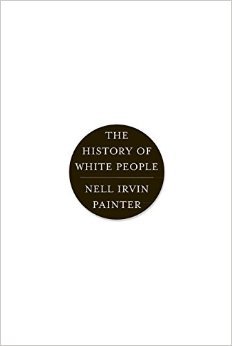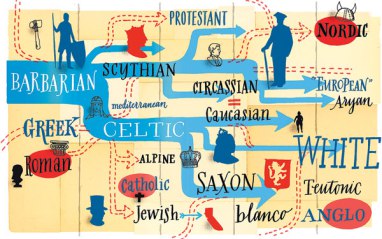 Nell Irvin Painter, 2010
Nell Irvin Painter, 2010
Looking for some clarity amidst our tumultuous news cycle filled with constant reports of an ever increasing normalization of nationalistic fueled racism, I decided I needed some historical non-fiction to realign my perspective about what is going on. The intriguing title of The History of White People captured my attention. The history cataloged in these pages isn’t really a history of white people’s actions but rather an academic exposition on the history and development of the ideas of race, namely the so-called race of white people. Nell Irvin Painter is an American History professor at Princeton and in her introduction to this highly academic but readable work she acknowledges that her working title, Constructions of White Americans from Antiquity to Present, would better summarize her intention to explore the understanding that “race is an idea, not a fact” (ix) and that American history often includes commentary on the the meaning of what it means to be non-white with too little focus or attention on the confusing and flexible ideas of what it means to be “white.”
The History of White People provides a compelling investigation into the constantly morphing ideas of race while illuminating the fact that race classification is relatively new in the scope of human history. Although this book is primarily focused on American ideas of race, Painter begins this historical investigation with a brief summary of the ancient Greek and Roman relationships with the peoples from the regions surrounding the Black Sea and Northern Europe. The Black Sea, Scythian people were from the Caucasus Mountainous region and played into much of mythology of Ancient Greece as a region of distant and wild people. To the Romans, the people of Northern Europe were wild savage and without civility. These regions, celebrated in modern times as the fruit basket of white superiority were looked down upon as brutish by the classical ancient civilizations of Greece and Rome. The Greek and Roman people did not refer to these people as white or fair or beautiful, but rather considered these people as ugly and savage.
Furthermore, both Greece and Rome utilized slaves in their society and people from both the Caucasus region and Europe were frequently enslaved by the the Greeks, the Romans, and later the Nordics. Slavery is not unique to the African people and throughout history many white people were included in the slave class. Even the later development of European feudalism with serfs subject to their local monarchy is a modified form of slavery and after discovery of the “new” world many white people were part of the slave class through indentured servitude. The ideas that Africans were subject to slavery in America due to their social and intellectual inferiority are flimsy when faced with the historical fact that European peoples have been enslaved and part of the slave class throughout antiquity and even up to the colonial era.
So, how did the idea that white people are superior come into being? The History of White People demonstrates that there are multifaceted reasons for the development of this false idea. Ideals about beauty developed within art criticism that influenced popular perception. For instance, in the 18th century ideals of purity developed with consideration of the artistic achievements of classical greatness. In the 18th century: “Copying Greek art perforce employed a more common medium – white plaster – which … they purposefully left unpainted. Thus [a] white aesthetic marched on, trampling the fact that smooth white Italian marble was neither the original medium nor the original color of the Greek statuary” (62). Additionally, ideals of white slave prostitutes from the Circassian, Georgian, and Caucasus regions were depicted in paintings as an ideal of human physicality and thus further escalating the ideal of white superiority over other “races.”
Of course art was not the primary or solitary element to the development of white race theory, but these examples demonstrate how art did influence the intellectual class’s perception of race whereas economies of power influenced the merchant and agrarian classes. The behaviors of the merchant and agrarian classes in America were observed by academics who studied the developing cultures of the American people. The early 19th century French social theorist, Alexis de Tocqueville, traveled through America and recognized the difference between northern whites and southern whites, most notably in their treatment of the black man. Tocqueville wrote “If America ever experiences great revolutions, they will be instigated by the presence of blacks on American soil; that is to say, it will not be the equality of social conditions but rather their inequality that which will give rise to them.” (127)
 America’s relationship to slavery is a shameful tarnish on its history, and the treatment of negro/black/African people is fraught with complexity. At the founding of the nation free black men did not have the right to vote and were not full citizens. However, the contemporary idea of a free white man is not as congruent with history’s identification of who defined themselves as a white man. Today whiteness has come to simply refer to European descent, but in the 18th and 19th century there were theories that there were many European races.
America’s relationship to slavery is a shameful tarnish on its history, and the treatment of negro/black/African people is fraught with complexity. At the founding of the nation free black men did not have the right to vote and were not full citizens. However, the contemporary idea of a free white man is not as congruent with history’s identification of who defined themselves as a white man. Today whiteness has come to simply refer to European descent, but in the 18th and 19th century there were theories that there were many European races.
Throughout its pages, The History of White People catalogs many different philosophers, authors, researchers, and eugenic sociologists that aimed to define the superior white race and I won’t get into all of the details here, but the central idea of this catologicial depiction is that the history of white identity isn’t as simple as European descent equates whiteness. As successive waves of immigrants began migrating to America throughout the middle of the 19th century, these immigrants were identified as a threat to the American culture and purity of the race of white peoples that had initially founded the former colonial nation. The first waves of immigrants were Irish and “The first assumption that the Irish were unfit for self-government often dominated domestic politics. The United States had black people and slavery to contend with, issues so huge that they blunted anti-Irish sentiment as a source of political conflict, but not before a decade of turmoil. The 1840’s were a tense time in the United States, an era of rising nativism” (146-7).
America’s problematic relationship with immigration is longstanding and reading about the anti-Irish and anti-German sentiments of the 1840’s is eerily similar to the current anti-Muslim anti-Latino sentiment of today. The fear of immigrants is nothing new and it was surprising to be reminded of America’s heritage of anti-immigrant sentiment. For instance, “a political party spun out of the Supreme Order of the Star-Spangled Banner was actually named the American Party. So patriotic a title encouraged members to brand opponents “anti-American.” In the Midwest for instance, where Germans had settled and voted in large numbers, refugees from the European revolutions of 1848 almost automatically seemed anti-American on account of their suspected radicalism” (148). The anti-American patriotic drum-beating continues on today with the America-First attitude that perpetuates the ongoing fear of the other.
Race theory fed these fears by promoting ideals of superior Nordic, or Teutonic, or Aryan races as the pinnacle of human civilization. Furthermore, as evolutionary theory came onto the scientific stage, the concepts of fitness additionally influenced these ideas of superiority among the races. What is distinct though, is that much of the race theory of the 19th century entirely ignored the dichotomy of white/black race classification that was at the forefront of the 20th century. In the 19th century the races of concern were Nordic or Teutonic, Alpine, and Mediterranean. Today we here these words and think of European regions, not races and this contemporary understanding illuminates how fluid and flawed race classification has been throughout history. The commonly used term, Caucasian, is really meaningless because most white people who today define themselves as Caucasian have no heritage with the region of the Caucasus Mountains, but that term arose from ideals of Caucasian beauty depicted in art. Furthermore, take the term Aryan, which is totally made up and does not even stem from Europe at all, for “Gobineau took the concept of an Aryan “race” out of the obscure scholarship of philologists studying dead languages like Sanskrit and eventually made it familiar…Thus, the nineteenth-century rage for races turned languages into peoples, and the word arya meaning “noble” or “spiritual” in Sanskrit came to be applied to an imagined, superior race of Aryans” (196). These labels fueled ideals of superiority and purity but have little basis in actual fact.
As immigrants continued to migrate to America at the turn of the 2oth century, race theorists such as Henry Goddard developed immigrant intelligence testing that promoted sterilization for the betterment of the humanity. These tests were skewed and intentionally filtered out non desirable cultural traits that had little to do with actual intelligence as defined today. There were dictionaries of races that separated out European immigrants into three races of Nordic, Alpine, and Mediterranean (289) that had originally included Germans in the superior Nordic race but “after a war in which Germans had been stereotyped as the “Hun,” German “blood” was downgraded from heavily Nordic to majority Alpine” (289). All of this demonstrates how nativist attitudes comfortably stereotyped the other as lesser and used pseudoscientific rational justification to drive policy.
Returning back to the issue with immigration, what is surprising about the history of white people is that the people who are easily considered white today were not formerly thought as such. Irish, Germans and Italians found there way within American society, but it was not an easy path. Voting and work provided a path for immigrants to enter into the American fold, however the non-white colored were often excluded from this path. “The right to vote, for instance, opened a path to employment through government patronage and civil service jobs. Labor union control meant that their sons and brothers stood first in line for steady work and, later, skilled jobs. The figure of the Irish policemen owes its longevity to this system of public employment” (205).
Of course, much of this history of white people is really the history of white men since women had little power in the young American government. As women began to fight for their right to participate in society the turn of the century suffragette movement was “Turning away from the nineteenth-century pattern of charity intended to correct personal weaknesses, they recognized the structural causes of poverty. Localities, states and even the federal government, they said, owed the population certain services as rights, because environment, not inherent weakness, made people poor” (242). These new ideas influenced the ideas of white racial stereotypes, transforming itself into ideas of class distinction. The focus changed from racial limitations to the opportunities provided through work as the immigrant class who “were living in miserable slums, impoverished immigrant laborers recognized that the fundamental flaw of American society lay in the maldistribution of wealth” (354) and not racial heritage (for white people at least).
As post war society dramatically transformed the nation the immigrant classes that were formerly thought of as separate races were welcomed into the fold of whiteness through work. In the 1940’s “With real American identity coded according to race, being a real American often meant joining antiblack racism and seeing oneself as white against blacks” (363) and “Nowadays race leads directly to race as black, as in the black/white scheme of the South where the civil rights revolution became visible. Black power took the concept even further, making black race a positive sign and white race the mark of guilty malfeasance.” (378)
The History of White People is a fairly impressive book, however I must acknowledge that I was a little disappointed by the unbalanced pacing of the heavy focus on the 18th and 19th century with a very brief summary of the changes of the 20th century. In reference to the Civil Rights era there is a long discussion on the influence of Malcom X with not one mention of Martin Luther King Jr., which was utterly surprising. Additionally, the closing of the book offers itself up to criticism of naivete as Painter celebrates the movement towards a post-racial America since people of color are respected in the popular culture and Barak Obama is president. Of course this book was published in 2010 and much has changed in the American lexicon of race in the post-Trump America and I wonder if a revised edition would edit much of this naivete with a more thoroughly researched exploration of the continued development of racial disparity within American culture.
Additionally, as I had stated in my opening paragraph, this book is not really an exploration of white people’s behaviors and I in my reading I was a little surprised at how much focus there was on particular theorists and authors that studied race in the 18th, 19th, and early 20th century with little exposition of actual white culture or events that influenced the general public zeitgeist of the times. This is an academically researched work but its weakness is that it leans to heavily on other academics and does little to depict actual historical events. This weakness does not fail the book though, for it does succeed in achieving its goal to demonstrate that the idea of race is simply that, an idea. The evolution and change of white people’s own understanding and classification of themselves demonstrates how foolish it is for humanity to place labels on one another due to skin colors that evolved due to environmental influences. The book closes with a brief acknowledgment to the 21st century achievements in genetics and the mapping of the human genome, which has demonstrated that all of humanity shares 99.99 percent of the same genes. This biological fact demonstrates that the ideas of racial difference ignore the commonality shared by all of humanity.
Advertisements Like this:Like Loading... Related





